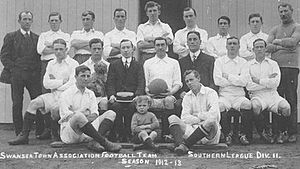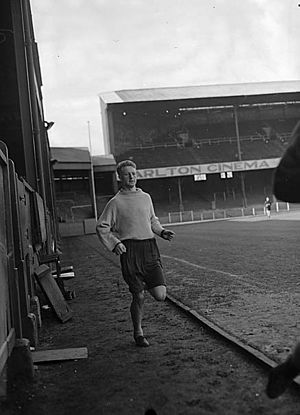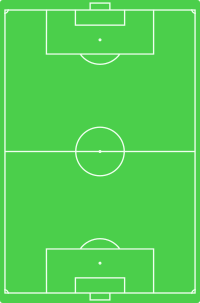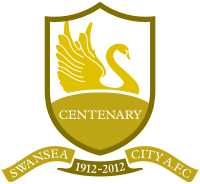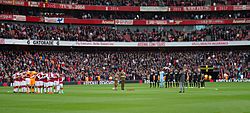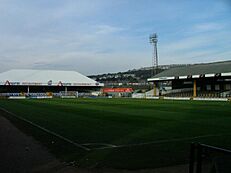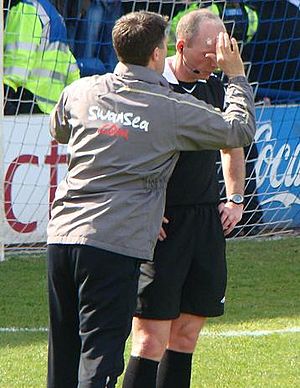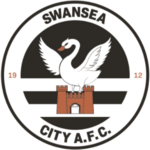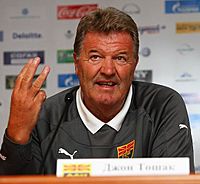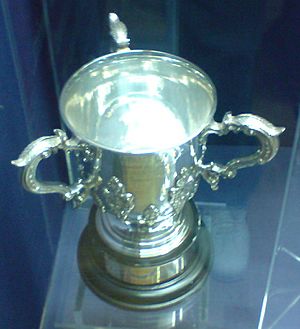Swansea City A.F.C. facts for kids
 |
||
| Full name | Swansea City Association Football Club | |
|---|---|---|
| Nickname(s) |
|
|
| Founded | 1912, as Swansea Town | |
| Ground | Swansea.com Stadium | |
| Capacity | 21,088 | |
| Owner(s) | Swansea Football LLC (majority) Nigel Morris (14.04%) Swansea City Supporters Society Ltd (7.59%) |
|
| Chief executive | Tom Gorringe | |
| Head coach | Alan Sheehan | |
| League | Championship | |
| 2018–19 | Championship, 10th of 24 | |
|
|
||
Swansea City Association Football Club is a professional football team from Swansea, Wales. They are known as "The Swans" or "The Jacks". The club plays in the EFL Championship, which is the second highest league in English football. Since 2005, Swansea City has played its home games at the Swansea.com Stadium, which used to be called the Liberty Stadium. Before that, they played at the Vetch Field from when the club was founded.
The club started in 1912 as Swansea Town. They joined the Southern League and won the Welsh Cup in their very first season. In 1920, they joined the English Football League. They won the Football League Third Division South title in 1924–25 and again in 1948–49. The club changed its name to Swansea City in 1969 when Swansea became a city.
Swansea City had a rapid rise in the early 1980s, getting promoted three times in four seasons to reach the top league in 1981. They finished sixth the next season, which is their best ever league finish. In 2011, they were promoted to the Premier League. Two years later, they won the League Cup, beating Bradford City 5–0 in the final. This was their first major trophy and earned them a spot in the 2013–14 UEFA Europa League. The club was relegated from the Premier League at the end of the 2017–18 season.
The story of Swansea City's journey from the fourth division to the top league is told in the 2014 film, Jack to a King – The Swansea Story. The club's supporters also own shares in the club through the Swansea City Supporters Trust.
Contents
- Club History
- Early Years and First Success (1912–1945)
- Post-War Era (1945–1965)
- Tough Times and Name Change (1965–1977)
- The Rise and Fall (1977–1986)
- Stability and Wembley Appearance (1986–1995)
- Challenging Times and Promotion (1995–2001)
- Final Years at Vetch Field (2001–2005)
- New Stadium and Premier League Promotion (2005–2011)
- Premier League and European Football (2011–2018)
- Return to the Championship (2018–Present)
- Stadiums
- Rivalries
- Club Identity
- European Competitions
- Club Players
- Club Management
- Club Records and Statistics
- Club Honours
- See also
Club History
Early Years and First Success (1912–1945)
Before Swansea Town AFC was formed in 1912, the area was more known for rugby. The club joined the Southern League and rented a field called Vetch Field for their home games. This field was named after the "vetch" plants that grew there.
Swansea's first professional match was a 1–1 draw against Cardiff City on 7 September 1912. In that first season, they won the Welsh Cup. They also famously beat the English champions Blackburn Rovers 1–0 in the FA Cup in 1914.
After World War I, Swansea Town became one of the founding members of the new Football League Third Division in 1920. In 1925, they reached the Football League Second Division for the first time, winning their division by staying unbeaten at home all season. The next year, they reached the semi-finals of the FA Cup. In 1926–27, they even beat Real Madrid 3–0 during a tour.
Post-War Era (1945–1965)
After World War II, Swansea Town was relegated back to Division Three (South) in 1946. However, they quickly bounced back, winning the division again in 1948–49. They only dropped one point at home all season, finishing seven points clear of second place.
For the next 15 years, Swansea played in the Second Division. In the 1955–56 season, with star players like Ivor Allchurch and Terry Medwin, they were in a strong position for promotion. However, injuries and player sales meant they eventually finished tenth.
In 1964, Swansea reached the FA Cup semi-finals for the second time. They caused a big upset by beating league leaders Liverpool 2–1 at Anfield. They then faced Preston North End in the semi-final but lost 2–1. The team was relegated to the Third Division in 1965.
Tough Times and Name Change (1965–1977)
After relegation, Trevor Morris, the manager, was replaced by former player Glyn Davies. Even with Ivor Allchurch returning, the team struggled and was relegated to Division Four in 1967. A record crowd of 32,796 watched them play Arsenal in the FA Cup in 1968.
A sad event happened in 1969 when players Roy Evans and Brian Purcell died in a car crash. Later that year, the club changed its name to Swansea City to reflect Swansea's new status as a city. Under manager Roy Bentley, they were promoted back to the Third Division. However, they were relegated again in 1973.
Attendances dropped, and in 1975, Swansea City had to apply to stay in the Football League after finishing near the bottom. Luckily, their application was successful.
The Rise and Fall (1977–1986)
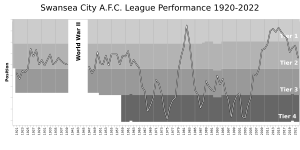
In February 1978, John Toshack, a former Liverpool and Wales striker, became manager at just 28 years old. This began an amazing climb for the club. They were promoted from the Fourth Division that season, achieving their biggest league win ever (8–0 against Hartlepool United). Sadly, assistant manager Harry Griffiths passed away shortly before promotion was secured.
The next season, Swansea earned another promotion, returning to the Football League Second Division after 14 years. On 2 May 1981, Swansea City won 3–1 against Preston North End to reach the Football League First Division for the first time in their history. This meant three promotions in just four seasons, a record in English football shared with Wimbledon F.C.. They also won the Welsh Cup, qualifying for European competition.
The 1981–82 season started with a fantastic 5–1 win over Leeds United. Swansea even topped the league several times, beating big teams like Liverpool and Manchester United. However, injuries to key players meant they finished sixth.
After this success, the club suffered two quick relegations, and Toshack was sacked. By 1985, the club faced serious financial problems and was almost shut down. Local businessman Doug Sharpe saved the club, but they were relegated to the Football League Fourth Division in 1986.
Stability and Wembley Appearance (1986–1995)
Swansea won promotion from the Fourth Division in 1988 through the new play-offs. They then stayed in the third tier for eight seasons, which was a long period of stability for the club. Under managers like Terry Yorath and Frank Burrows, they reached the play-off semi-finals in 1993.
In 1994, Burrows led the Swans to their first ever appearance at Wembley Stadium for the Autoglass Trophy final. They drew 1–1 with Huddersfield Town and then won 3–1 on penalties, lifting the trophy.
The 1995–96 season ended with relegation back to the third division. A very poor second half of the season, including a 7–0 FA Cup defeat to Fulham, led to their drop.
Challenging Times and Promotion (1995–2001)
Relegation in 1996 was a chaotic season with four different managers. Kevin Cullis was briefly appointed but sacked after just six days. Jan Mølby, a former Liverpool player, then took over. In 1997, the club reached the Third Division play-off final but lost to Northampton Town in the last minute. Mølby was sacked the next season.
John Hollins became manager, and things improved. In 1999, they reached the promotion play-offs again but lost in extra time. That season, they famously beat Premiership team West Ham United in the FA Cup, becoming the first team from the bottom division to do so since the Premier League started.
In 2000, Swansea was promoted as Division Three champions. They had a strong defense, conceding only 32 goals all season, and set a record of nine consecutive league victories. Promotion was secured with a 3–0 win over Exeter City at the Vetch Field. However, the celebration was overshadowed by the tragic death of a supporter, Terry Coles, after the final game of the season.
The team was relegated just 12 months later in May 2001. Hollins had not strengthened the squad, and they won only eight games all season.
Final Years at Vetch Field (2001–2005)
In 2001, the club was sold to a group of Australian businessmen led by Tony Petty. This caused a lot of problems, with players being sacked and contracts ended. This led to the creation of the Swansea City supporters' trust, which aimed to protect the club and give fans a say in its running.
The Petty group sold their shares in January 2002 to a local group led by Mel Nurse. Despite the off-field issues, the team avoided relegation to the Football Conference on the last day of the 2002–03 season, at the expense of Exeter City.
Under manager Brian Flynn, Swansea finished 10th in 2003–04 and reached the fifth round of the FA Cup. Flynn was replaced by Kenny Jackett. In their last season at the Vetch Field, 2004–05, Swansea won promotion back to League One on the final day. The last league goal at the Vetch Field was scored by Adrian Forbes on 30 April 2005.
New Stadium and Premier League Promotion (2005–2011)
In the summer of 2005, the club moved to the new Liberty Stadium. Their first game there was a 1–0 victory against Tranmere Rovers. In their first season back in League One, Swansea reached the play-off final but lost on penalties to Barnsley. They did win the Football League Trophy and the FAW Premier Cup that season.
Manager Roberto Martínez arrived in 2007. The following season, an 18-game unbeaten run helped them win the League One title. They earned 92 points, the highest ever by a Welsh club in the Football League.
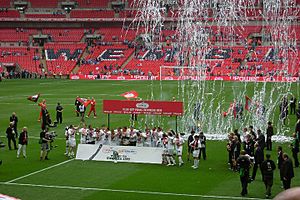
After 24 years, Swansea City returned to the second tier of English football. They finished eighth in 2008–09 and just missed the play-offs in 2009–10. Martínez left for Wigan Athletic in 2009, and Paulo Sousa took over. Sadly, in May 2010, Swansea player Besian Idrizaj suffered a heart attack and passed away. The club retired his number 40 shirt in his memory.
Northern Irishman Brendan Rodgers became manager for the 2010–11 season. He led the club to a third-place finish and a spot in the Championship play-offs. After beating Nottingham Forest in the semi-final, they defeated Reading 4–2 in the final at Wembley Stadium, with Scott Sinclair scoring three goals. This win promoted Swansea to the Premier League.
Premier League and European Football (2011–2018)
Swansea became the first Welsh team to play in the Premier League since it started in 1992. They signed Danny Graham for a club record fee. They beat teams like Arsenal, Liverpool, and Manchester City at home. Swansea finished their first Premier League season in 11th place.
At the end of that season, Brendan Rodgers left to manage Liverpool. Michael Laudrup took over for the 2012–13 season, which was the club's 100th anniversary. Laudrup's first league game was a fantastic 5–0 win over Queens Park Rangers. Swansea even topped the Premier League table for a short time.
On 24 February 2013, Swansea beat Bradford City 5–0 in the League Cup final. This was the biggest winning margin in the competition's final and Swansea's first major trophy. This win also qualified them for the 2013–14 UEFA Europa League. Swansea finished the Premier League season in ninth place. In July, they signed striker Wilfried Bony for a club record fee of £12 million.

Swansea had early success in Europe, beating Spanish side Valencia 3–0 away. In February 2014, Laudrup was dismissed, and defender Garry Monk became player-manager. In Monk's first game, Swansea beat Cardiff 3–0. They exited the Europa League after losing to Napoli.
In January 2015, Wilfried Bony was sold to Manchester City for a club record £25 million. Swansea City finished eighth in the Premier League in 2014–15, their highest position and points total in the Premier League. They also beat Arsenal and Manchester United twice that season.
On 9 December 2015, Garry Monk was sacked. After a period with Alan Curtis as caretaker, Francesco Guidolin became manager. In July 2016, an American group led by Jason Levien and Steven Kaplan bought a majority share in the club. Guidolin was sacked in October 2016 and replaced by American coach Bob Bradley, who was the first American manager in the Premier League. Bradley was sacked after just 85 days.
On 3 January 2017, Paul Clement took charge. He led Swansea to safety in the 2016–17 season, helping them climb from the bottom of the table at Christmas. However, a poor start to the 2017–18 season led to Clement's sacking in December 2017. He was replaced by Carlos Carvalhal. Despite some good home wins, Swansea were relegated on 13 May 2018, after losing to Stoke City.
Return to the Championship (2018–Present)
On 11 June 2018, Graham Potter became the new manager. The club finished 10th in their first season back in the Championship and reached the FA Cup quarter-finals. Potter left to manage Brighton at the end of the season.
Steve Cooper took over. In September 2019, Swansea had their best start to a season in 41 years. They finished sixth in the 2019–20 season, making it to the play-offs, but lost to Brentford in the semi-final.
At the end of the 2020–21 season, Swansea finished 4th and reached the play-off final again, but lost to Brentford at Wembley Stadium. After Cooper left, Russell Martin became head coach in 2021. He led the club to mid-table finishes before moving to Southampton in 2023. For the 2023–24 season, Michael Duff was manager but was dismissed after five months. Luke Williams then guided the team to 14th place. Williams was sacked in February 2025, and Alan Sheehan was named as his replacement.
Stadiums
Vetch Field: The Historic Home
Before Swansea Town was formed, children played football on a piece of land where "vetch" plants grew. This land was owned by Swansea Gaslight Company and became the club's first home in 1912. The Vetch Field originally held 12,000 fans. Its highest attendance was 32,786 for an FA Cup match against Arsenal in 1968. The last league goal scored at the Vetch was by Adrian Forbes on 30 April 2005.
Swansea.com Stadium: The Modern Era
As the Vetch Field became old, Swansea City looked for a new home. The Swansea City Council helped create a plan for a new stadium. On 23 July 2005, the Liberty Stadium officially opened with a friendly game against Fulham.
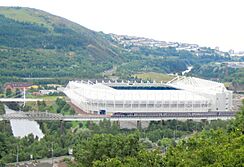
The Liberty Stadium has a capacity of 21,088. The highest attendance recorded there was 20,937 for a game against Arsenal in 2015. The stadium has also hosted three Welsh international football matches.
In 2012, Swansea City announced plans to expand the Liberty Stadium by about 12,000 seats, which would make it the largest sports club-owned stadium in Wales. On 9 August 2021, the Liberty Stadium was renamed the Swansea.com Stadium after a 10-year naming rights deal.
Rivalries
South Wales Derby
Swansea City's biggest rivals are Cardiff City. Matches between these two clubs are known as the South Wales derbies and are often very intense. The rivalry became strong in the late 1960s.
Swansea has won 42 of the 115 competitive matches against Cardiff, while Cardiff has won 45, with 28 draws. Cardiff's biggest win was 5–0 in 1965. In the 2021–22 season, Swansea made history by becoming the first team to win both league derby matches in a single season, beating Cardiff 3–0 at home and 4–0 away.
The derby matches can sometimes be controversial. In a League Cup match in 2008, fans clashed with police. In a 2010 league game at Ninian Park, referee Mike Dean was hit by a coin from a Cardiff City supporter.
When both teams were in the Premier League in the 2013–14 season, Cardiff won the first Premier League derby 1–0. However, Swansea got revenge with a convincing 3–0 win in the return fixture. More recently, in the 2020–21 season, Jamal Lowe scored two goals in a 2–0 Swansea win. In the 2021–22 season, Swansea won both derbies again, making it four consecutive derby wins.
Other Rivalries
Swansea City also has rivalries with Newport County and, to a lesser extent, Bristol City and Bristol Rovers. However, Swansea rarely plays Newport because they are currently in different leagues.
Club Identity
Nicknames
People from Swansea are often called "Jacks," and this nickname is also used for the football club. According to a history professor, "Jack" was a common nickname for sailors, and people would refer to sailors from Swansea as "Swansea Jack." A famous local lifeguard dog in the 1930s was also named Swansea Jack, which helped make the name even more popular.
Kits and Crests
When the club started in 1912, Swansea Town chose white shirts and shorts, similar to the local rugby team, Swansea RFC. The main secondary colors on their home kit have usually been black, but they used orange in the 1960s and red in the 1990s and 2000s. In 2012–13, the club celebrated its 100th anniversary with a special copper-trimmed kit and a commemorative crest.
In 1998, new owners changed the club crest because the swan on it was not easily recognized, and the background was blue, which is the color of rivals Cardiff City. In 2021, to celebrate 40 years since their first promotion to the top league, Swansea City brought back the badge that was used before the 1998 design. The 1998 crest was reintroduced to kits in 2023.
Kit Manufacturers and Sponsors
| Period | Kit manufacturer | Shirt sponsor |
|---|---|---|
| 1975–1979 | Bukta | none |
| 1979–1981 | Adidas | |
| 1981–1984 | Patrick | |
| 1984–1985 | Hummel | Diversified Products (DP) |
| 1986–1989 | Admiral Sportswear | |
| 1989–1991 | Spall Sports | |
| 1991–1992 | none | |
| 1992–1993 | Matchwinner | ACTION |
| 1993–1995 | Gulf Oil | |
| 1995–1996 | Le Coq Sportif | |
| 1996–1997 | South Wales Evening Post | |
| 1997–1999 | New Balance | Silver Shield |
| 1999–2000 | M&P Bikes | |
| 2000–2001 | Bergoni | Stretchout |
| 2001–2004 | The Travel House | |
| 2004–2005 | RE/MAX | |
| 2005–2007 | Macron | The Travel House |
| 2007–2008 | swansea.com | |
| 2008–2009 | Umbro | |
| 2009–2011 | 32Red | |
| 2011–2013 | Adidas | |
| 2013–2016 | GWFX | |
| 2016–2017 | Joma | BETEAST |
| 2017–2018 | LeTou | |
| 2018–2019 | Bet UK | |
| 2019–2020 | YOBET | |
| 2020–2022 | Swansea University | |
| 2022–2023 | Westacres (Home) Swansea University (Away) Owens (Third) |
|
| 2023–present | Reviva (Home) Westacres (Away and Third) |
European Competitions
Swansea City has played in European competitions several times. Their biggest win in Europe was 12–0 against Sliema Wanderers in 1982. In the 2013–14 season, they played in the UEFA Europa League after winning the League Cup. They had a great start, beating Spanish side Valencia 3–0 away from home. They reached the Round of 32 but were knocked out by Napoli.
| Season | Competition | Round | Opponent | Home | Away | Aggregate | Refs |
|---|---|---|---|---|---|---|---|
| 1961–62 | UEFA Cup Winners' Cup | Preliminary round | 2–2 | 1–5 | 3–7 | ||
| 1966–67 | UEFA Cup Winners' Cup | First round | 1–1 | 0–4 | 1–5 | ||
| 1981–82 | UEFA Cup Winners' Cup | First round | 0–1 | 1–2 | 1–3 | ||
| 1982–83 | UEFA Cup Winners' Cup | Preliminary round | 3–0 | 0–1 | 3–1 | ||
| First round | 12–0 | 5–0 | 17–0 | ||||
| Second round | 0–1 | 0–2 | 0–3 | ||||
| 1983–84 | UEFA Cup Winners' Cup | Preliminary round | 1–1 | 0–1 | 1–2 | ||
| 1989–90 | UEFA Cup Winners' Cup | First round | 2–3 | 3–3 | 5–6 | ||
| 1991–92 | UEFA Cup Winners' Cup | First round | 1–2 | 0–8 | 1–10 | ||
| 2013–14 | UEFA Europa League | Third qualifying round | 4–0 | 0–0 | 4–0 | ||
| Play-off round | 5–1 | 1–2 | 6–3 | ||||
| Group stage | 1–1 | 1–1 | 2nd place | ||||
| 1–0 | 0–1 | ||||||
| 0–1 | 3–0 | ||||||
| Round of 32 | 0–0 | 1–3 | 1–3 |
Club Players
Current Team Squad
|
|
Players on Loan
|
|
Retired Shirt Numbers
|
Club Management
Club Officials
Some of the main owners of Swansea City include Andy Coleman, Brett Cravatt, and Jason Cohen (through Swansea Football LLC), and Nigel Morris. The Swansea City Supporters Society Ltd also owns shares. Famous people like Luka Modrić and Snoop Dogg are also investors in the club.
| Position | Name |
|---|---|
| Honorary Club President | Alan Curtis |
| Chief Executive Officer | Tom Gorringe |
| Director of Football | Richard Montague |
| Directors | Andy Coleman Brett Cravatt Jason Cohen George Popstefanov Chris Sznewajs Tyler Morse Nigel Morris Todd Marcelle Keith English Martin Morgan Paul Meller (Supporter Director) Diane Hughes |
First-Team Staff
| Position | Name |
|---|---|
| Head coach | Alan Sheehan |
| Assistant head coach | Darren O'Dea |
| First-team coaches | Richard Stearman Kristian O'Leary |
| Head of goalkeeping | Martyn Margetson |
| Head of medical | Dr. Jez McCluskey |
| Head physiotherapist | Thomas Gittoes |
| First-team kit manager | Michael Eames |
Academy Staff
| Position | Name |
|---|---|
| Academy manager | Ryan Davies |
| Head of operations | Rebecca Gigg |
| Head of coaching | Liam McGarry |
| Under 21s coach | Anthony Wright |
| Under 18s coach | Joe Roberts |
| Head of youth development phase | Matthew Layton |
Club Managers
Swansea City has had many managers since Walter Whittaker was appointed in 1912. Whittaker led Swansea to their first Welsh Cup win. Haydn Green was the longest-serving manager, staying for over eight years, including during World War II. Trevor Morris managed the most games and was the first manager to lead a Welsh club in Europe.
John Toshack is Swansea City's most successful manager. He led the club to three league promotions and three Welsh Cup wins. He also guided them to their highest league finish ever, sixth place in the top division in 1981–82. In 2011, Brendan Rodgers led Swansea City to promotion to the Premier League. During Swansea City's 100th year (2012–13), Michael Laudrup led the club to win the League Cup for the first time, which was their first major trophy.
Club Records and Statistics
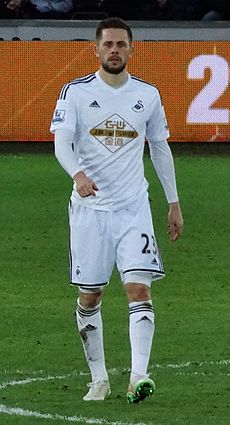
Wilfred Milne holds the record for the most appearances for Swansea, playing 586 matches between 1920 and 1937. Roger Freestone is second with 563 games. The player with the most international caps while at the club is Ashley Williams, who played 50 times for Wales.
The club's all-time leading goal scorer is Ivor Allchurch, with 166 goals. Cyril Pearce holds the record for most goals in a single season, scoring 35 league goals and 40 goals overall in 1931–32.
Swansea's biggest win was 12–0 against Sliema in the European Cup Winners Cup in 1982. Their largest FA Cup win was 8–1 against Notts County in 2018, which is also their biggest win at the Liberty Stadium.
The record attendance at the Vetch Field was 32,796 for an FA Cup match against Arsenal in 1968. The club's record transfer fee paid for a player was £18 million for André Ayew in January 2018. The most expensive player sold by Swansea was Gylfi Sigurðsson, who joined Everton in August 2017 for an estimated £45 million.
Club Honours
Swansea City's first trophy was the Welsh Cup, which they won in 1913. Their first league title was the 1924–25 Football League Third Division South. Since then, Swansea has won the League Cup once, the Football League Trophy twice, and the Welsh Cup ten times. They have also played in the UEFA Cup Winners' Cup seven times and the UEFA Europa League once.
Here are some of Swansea City's main achievements:
League Titles
- Second Division / Championship (level 2)
- Promoted: 1980–81
- Play-off winners: 2011
- Third Division South / Third Division / League One (level 3)
- Champions: 1924–25, 1948–49, 2007–08
- Promoted: 1978–79
- Fourth Division / Third Division / League Two (level 4)
- Champions: 1999–2000
- Promoted: 1969–70, 1977–78, 2004–05
- Play-off winners: 1988
Cup Competitions
- Football League Cup
- Winners: 2012–13
- Football League Trophy
- Winners: 1993–94, 2005–06
- Welsh Cup
- Winners (10): 1912–13, 1931–32, 1949–50, 1960–61, 1965–66, 1980–81, 1981–82, 1982–83, 1988–89, 1990–91
- FAW Premier Cup
- Winners: 2004–05, 2005–06
See also
 In Spanish: Swansea City Association Football Club para niños
In Spanish: Swansea City Association Football Club para niños


